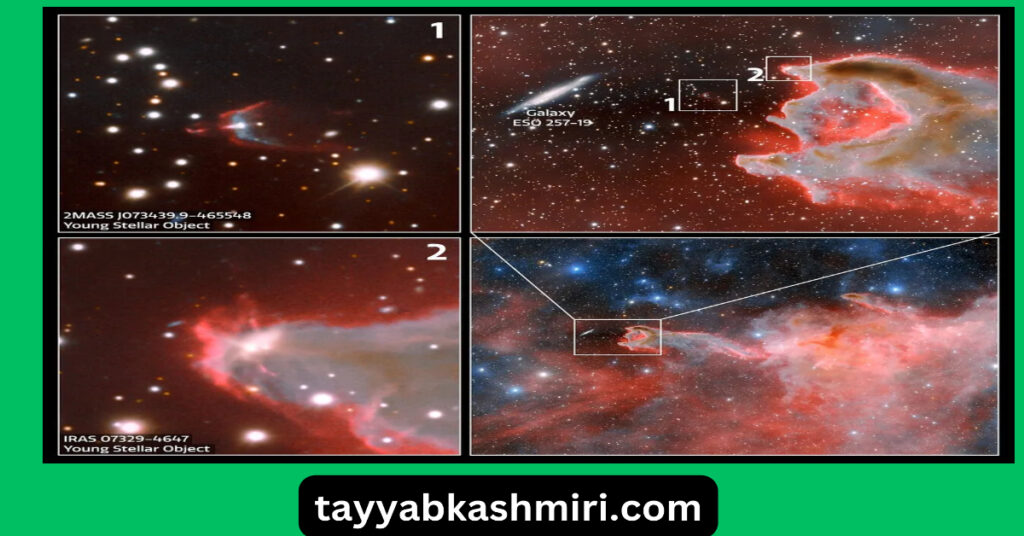Unraveling the Mystery of ‘God’s Hand’: A Cosmic Wonder That Baffles Astronomers
Table of Contents
The cosmos is a vast tapestry of wonders, and every once in a while, it unveils a sight so enigmatic that it leaves even the most seasoned astronomers in awe. Such is the case with the celestial phenomenon known as ‘God’s Hand,’ a striking cosmic formation that has puzzled scientists and captured the imagination of stargazers worldwide.

For More Articles : Visit Here
Motorola Moto G Stylus 5G 2024 : An Affordable $400 Mid-Range Smartphone With Vegan Leather Style

Discovered in 2022 by the European Southern Observatory’s Very Large Telescope (VLT) in Chile, ‘God’s Hand’ is a striking interstellar cloud of gas and dust located approximately 17,000 light-years away in the constellation Puppis. This mesmerizing celestial feature has earned its evocative moniker due to its uncanny resemblance to a hand-like structure reaching out from the depths of space.
The Breathtaking Beauty of ‘God’s Hand’ At first glance, ‘God’s Hand’ appears to be a vibrant, glowing entity against the inky blackness of deep space. Its intricate details, however, reveal a tapestry of cosmic wonders that have left astronomers scratching their heads.
The ‘hand’ itself is composed of dense clouds of interstellar gas and dust, primarily consisting of hydrogen, helium, and trace amounts of heavier elements. These clouds are illuminated by the intense radiation from nearby hot, young stars, causing them to glow with a distinctive reddish hue. The ‘fingers’ of the hand are formed by vast pillars of gas and dust, stretching out into the surrounding void, sculpted by the powerful winds and radiation emanating from these stellar bodies.
At the heart of this celestial wonder lies a fascinating mystery. The ‘palm’ of the hand is a region of intense star formation, where dense clumps of gas and dust are collapsing under their own gravitational pull, giving birth to new stars. These newborn stars, in turn, emit powerful winds and intense radiation that shape and sculpt the surrounding gas and dust, creating the intricate structures that make up ‘God’s Hand.’
Unanswered Questions and Scientific Puzzles While the stunning beauty of ‘God’s Hand’ is undeniable, its very existence poses a multitude of questions that have left astronomers scratching their heads. One of the most pressing mysteries surrounds the intricate filamentary structures that form the ‘fingers’ of the hand.
These slender pillars of gas and dust are incredibly fragile, and according to our current understanding of stellar physics, they should not be able to withstand the powerful forces exerted by the nearby hot, young stars for very long. Yet, ‘God’s Hand’ appears to be a relatively long-lived phenomenon, with these delicate structures persisting for thousands, if not millions, of years.
Astronomers have proposed various theories to explain this enigma, ranging from intricate interactions between stellar winds and magnetic fields to the presence of unseen, massive objects that could provide additional gravitational support for these fragile structures. However, none of these theories have been conclusively proven, leaving the true nature of ‘God’s Hand’ shrouded in uncertainty.
Another puzzling aspect of this celestial wonder is the intense star formation activity observed in the ‘palm’ region. While star formation is a common occurrence in dense molecular clouds, the sheer number and density of newborn stars in this region are remarkable. Additionally, the presence of these young, hot stars in such close proximity to the delicate gas and dust structures raises questions about how they formed and evolved without disrupting the intricate tendrils that make up ‘God’s Hand.’
Implications for Astronomical Research Beyond its mesmerizing beauty and scientific curiosities, ‘God’s Hand’ holds profound implications for our understanding of stellar evolution and the processes that shape the intricate structures found throughout the cosmos.
By studying this enigmatic formation, astronomers hope to gain valuable insights into the complex interplay between stars, gas, and dust in the early stages of stellar life cycles. The intricate structures observed in ‘God’s Hand’ could provide crucial clues about the formation and evolution of planetary systems, as well as the mechanisms that govern the birth and death of stars.
Moreover, the intense star formation activity observed in the ‘palm’ region offers a unique opportunity to study the processes that govern the formation of massive stars, which play a crucial role in shaping the chemical evolution of galaxies and the distribution of heavy elements throughout the universe.
Cutting-Edge Observations and Future Exploration To unravel the mysteries of ‘God’s Hand,’ astronomers are employing a wide array of cutting-edge observational techniques and instruments. The European Southern Observatory’s Very Large Telescope (VLT), which first captured the stunning images of this celestial wonder, continues to play a pivotal role in its study, providing high-resolution images and spectroscopic data that reveal the intricate details of its structure and composition.
Additionally, the Atacama Large Millimeter/submillimeter Array (ALMA), a powerful radio telescope located in the Atacama Desert of Chile, has been instrumental in probing the dense molecular clouds and cold gas reservoirs associated with ‘God’s Hand.’ By observing the emission of various molecular species, such as carbon monoxide and hydrogen cyanide, astronomers can map the distribution and dynamics of these cold, dense regions, shedding light on the processes that govern star formation.
Looking to the future, the upcoming James Webb Space Telescope (JWST), scheduled for launch in late 2021, promises to revolutionize our understanding of ‘God’s Hand’ and similar celestial formations. With its unprecedented infrared imaging and spectroscopic capabilities, the JWST will be able to peer through the dense clouds of gas and dust, revealing the faint, embedded protostars and protoplanetary disks that are currently obscured from view.
Furthermore, the JWST’s exquisite sensitivity will allow astronomers to study the chemical composition and physical properties of the gas and dust in unprecedented detail, providing crucial insights into the processes that shape these intricate structures and the environments in which stars and planets form.
‘God’s Hand’ as a Cosmic Inspiration Beyond its scientific significance, ‘God’s Hand’ has captured the imagination of stargazers, artists, and philosophers alike, serving as a cosmic reminder of the awe-inspiring beauty and profound mysteries that permeate the universe.
The iconic hand-like structure has inspired countless artistic interpretations, from paintings and sculptures to digital renderings and multimedia installations. Its evocative name and symbolism have also sparked philosophical discussions about the nature of existence, the role of divinity in the cosmos, and our place in the grand tapestry of the universe.
Moreover, ‘God’s Hand’ has become a powerful symbol of humanity’s enduring quest for knowledge and understanding. Just as the ancient philosophers gazed upon the heavens in search of cosmic truths, modern astronomers continue to push the boundaries of scientific exploration, driven by an insatiable curiosity and a desire to unravel the mysteries of the universe.
As we continue to study and observe ‘God’s Hand,’ it serves as a poignant reminder that the cosmos is a vast, ever-unfolding tapestry of wonders, and that our journey of discovery is far from over. With each new observation and insight, we inch closer to understanding the intricate workings of the universe, while simultaneously unveiling new layers of complexity and mystery that beckon us to explore further.
The Profound Impact of ‘God’s Hand’ on Scientific Outreach and Education Beyond its scientific and artistic significance, ‘God’s Hand’ has emerged as a powerful tool for science outreach and education, captivating the minds of students, educators, and the general public alike.
The mesmerizing imagery and cosmic grandeur of this celestial wonder have proven to be highly effective in sparking curiosity and igniting a passion for astronomy and space exploration. Science centers, planetariums, and educational institutions worldwide have embraced ‘God’s Hand’ as a compelling visual aid, using its striking appearance to introduce complex concepts in astrophysics, star formation, and the life cycle of stars.
Moreover, the enigmatic nature of ‘God’s Hand’ and the unanswered questions surrounding its formation and evolution have become powerful catalysts for inspiring critical thinking and fostering a spirit of scientific inquiry. By presenting students and the public with the perplexing mysteries of this cosmic phenomenon, educators can encourage them to engage in the scientific process, formulate hypotheses, and explore the importance of observation, data collection, and analysis in advancing our understanding of the universe.
The story of ‘God’s Hand’ also serves as a testament to the power of international collaboration and technological advancement in scientific exploration. The discovery and ongoing study of this celestial wonder have been made possible through the combined efforts of astronomers, engineers, and researchers from around the world, working together to push the boundaries of human knowledge.
By highlighting the role of cutting-edge observatories, such as the Very Large Telescope and the Atacama Large Millimeter/submillimeter Array, in unraveling the mysteries of ‘God’s Hand,’ educators can inspire students to pursue careers in science, technology, engineering, and mathematics (STEM), and contribute to the ongoing quest to explore and understand the cosmos.
Furthermore, the philosophical and artistic dimensions of ‘God’s Hand’ have opened up opportunities for interdisciplinary discussions and collaborations. Artists, philosophers, and theologians have engaged with the scientific community, exploring the intersection of science, art, and metaphysical inquiry, fostering a deeper appreciation for the profound beauty and mystery that permeate the universe.
As our understanding of ‘God’s Hand’ continues to evolve, its impact on scientific outreach and education is likely to grow, inspiring future generations of astronomers, scientists, and explorers to push the boundaries of human knowledge and unlock the secrets of the cosmos.
The Enduring Legacy of ‘God’s Hand’ As we gaze upon the awe-inspiring majesty of ‘God’s Hand,’ it becomes evident that this celestial wonder transcends its scientific significance. It stands as a testament to the enduring human spirit, our unquenchable thirst for knowledge, and our boundless capacity for wonder and curiosity.
Throughout history, cosmic phenomena have captured the imagination of humanity, inspiring us to ponder the depths of the universe and our place within it. From the ancient philosophers who gazed upon the heavens in search of cosmic truths to the modern astronomers who employ cutting-edge technology to unravel the mysteries of the cosmos, the pursuit of understanding has been a defining characteristic of our species.
‘God’s Hand’ represents a continuation of this noble quest, a cosmic beacon that beckons us to explore, question, and push the boundaries of our knowledge. Its enigmatic nature reminds us that the universe is a vast and ever-unfolding tapestry of wonders, and that our journey of discovery is far from over.
As we continue to study and observe this celestial phenomenon, it will undoubtedly reveal new insights and pose new questions, challenging our current understanding of stellar physics and the processes that shape the intricate structures of the cosmos. In doing so, it will catalyze further scientific exploration, technological innovation, and international collaboration, propelling us ever closer to unlocking the deepest secrets of the universe.
Moreover, the enduring legacy of ‘God’s Hand’ will extend beyond the realms of science, inspiring artistic expressions, philosophical contemplations, and spiritual awakenings. Its mesmerizing beauty and cosmic grandeur will continue to captivate the hearts and minds of people from all walks of life, reminding us of the profound mysteries and ineffable beauty that permeate the cosmos.
As we gaze upon the ‘fingers’ of ‘God’s Hand,’ reaching out from the depths of space, we are reminded of our own cosmic journey, our quest to understand the universe and our place within it. And in that moment, we are humbled by the vastness of the cosmos, awed by its beauty, and emboldened by the knowledge that our journey of discovery has only just begun.
Unveiling the Cosmic Tapestry: Unraveling the Mysteries of Star Formation
At the heart of the enduring fascination with ‘God’s Hand’ lies a profound scientific enigma – the intricate processes that govern the birth and evolution of stars. This celestial wonder offers a unique and tantalizing glimpse into the cosmic tapestry of star formation, a realm that continues to captivate and challenge astronomers worldwide.
The ‘palm’ region of ‘God’s Hand,’ a dense, glowing nexus of gas and dust, is a veritable nursery for newborn stars. Within this celestial cradle, astronomers have observed an astonishing number of protostars – dense, collapsing cores of gas and dust that represent the earliest stages of stellar evolution. These fledgling stellar bodies are surrounded by vast disks of material, the potential birthplaces of new planetary systems.
Studying these protostars and their enigmatic environments holds the key to unraveling the mysteries of star formation, a process that has profound implications for our understanding of the universe. By probing the physical and chemical conditions within the ‘palm’ region, astronomers can gain insights into the intricate interplay between gravity, turbulence, magnetic fields, and radiation that ultimately shape the formation and evolution of stars.
One of the most perplexing aspects of star formation is the mechanism by which these massive clouds of gas and dust, spanning light-years in size, collapse into the relatively tiny cores that eventually ignite as stars. Conventional theories suggest that this process is driven by the inexorable force of gravity, but the presence of turbulence and magnetic fields within these clouds adds a layer of complexity that challenges our current models.
‘God’s Hand’ offers a unique opportunity to study these intricate dynamics in action. The delicate filamentary structures that make up the ‘fingers’ of the hand are believed to be sculpted by the powerful outflows and radiation from the newborn stars within the ‘palm’ region. By mapping the distribution and kinematics of these tendrils, astronomers can gain valuable insights into the interplay between stellar feedback and the surrounding gas and dust, shedding light on the complex processes that shape the birth environments of stars.
Moreover, the intense star formation activity observed within the ‘palm’ region raises intriguing questions about the mechanisms that trigger and regulate this process. Are these stars formed in a single, concentrated burst of activity, or do they emerge over extended periods of time? What role do external triggers, such as stellar winds or supernova shockwaves, play in initiating the collapse of these massive clouds?
Answering these questions will require a multifaceted approach, combining high-resolution imaging from cutting-edge observatories with sophisticated computer simulations and theoretical models. The James Webb Space Telescope, with its unprecedented infrared capabilities, is poised to play a pivotal role in this endeavor, allowing astronomers to peer through the dense clouds of gas and dust and directly observe the earliest stages of star formation.
Furthermore, the study of ‘God’s Hand’ could have far-reaching implications for our understanding of the chemical evolution of galaxies and the distribution of heavy elements throughout the universe. Massive stars, born in regions like the ‘palm’ of ‘God’s Hand,’ are the primary sources of these heavy elements, which are synthesized in their cores and subsequently dispersed into the interstellar medium through powerful stellar winds and supernova explosions.
By unraveling the mysteries of star formation in ‘God’s Hand,’ astronomers can gain insights into the birth and evolution of these cosmic factories, and how they contribute to the enrichment of galaxies with the chemical building blocks necessary for the formation of planets and, ultimately, life itself.
The Celestial Symphony: Exploring the Interplay of Stars, Gas, and Dust
Beyond the intricate processes of star formation, ‘God’s Hand’ offers a unique window into the intricate interplay between stars, gas, and dust – a celestial symphony that shapes the evolution of galaxies and the structures we observe throughout the cosmos.
The delicate filamentary structures that make up the ‘fingers’ of ‘God’s Hand’ are a testament to the complex interactions between the hot, young stars within the ‘palm’ region and the surrounding interstellar medium. These tendrils, sculpted by the intense radiation and powerful stellar winds, are a living laboratory for studying the dynamic processes that shape the intricate structures observed in star-forming regions across the universe.
One of the most intriguing aspects of ‘God’s Hand’ is the apparent longevity of these delicate filaments. According to our current understanding of stellar physics, these fragile structures should be rapidly dispersed by the intense radiation and stellar winds emanating from the nearby hot, young stars. Yet, the ‘fingers’ of ‘God’s Hand’ have persisted for thousands, if not millions, of years, posing a profound challenge to our existing models.
Unraveling this enigma could have far-reaching implications for our understanding of the intricate interplay between stars and the interstellar medium. Some astronomers have proposed that magnetic fields may play a crucial role in providing additional support and stability to these delicate structures, while others suggest that the presence of dense, unseen clumps of gas and dust could contribute to their longevity.
Exploring these hypotheses will require a multifaceted approach, combining high-resolution observations from state-of-the-art observatories with sophisticated computer simulations and theoretical models. The Atacama Large Millimeter/submillimeter Array (ALMA), with its unparalleled sensitivity to the emission from cold molecular gas and dust, is poised to play a pivotal role in mapping the distribution and kinematics of these enigmatic filaments.
Moreover, the study of ‘God’s Hand’ could shed light on the processes that shape the intricate structures observed in other star-forming regions, such as the iconic Pillars of Creation in the Eagle Nebula. By understanding the mechanisms that govern the formation and evolution of these celestial sculptures, astronomers can gain deeper insights into the complex interplay between stars, gas, and dust that ultimately shapes the evolution of galaxies and the structures we observe throughout the universe.
Beyond its scientific significance, the intricate interplay between stars, gas, and dust in ‘God’s Hand’ offers a captivating visual metaphor for the interconnectedness of all things in the cosmos. Just as the delicate tendrils of gas and dust are sculpted and shaped by the powerful forces of nearby stars, our own existence is inextricably linked to the cosmic cycles of matter and energy that permeate the universe.
As we continue to unravel the mysteries of ‘God’s Hand,’ we are reminded that the cosmos is a vast, interconnected tapestry, where the fates of stars, galaxies, and even life itself are woven together in a celestial symphony that spans billions of years and light-years of space.








